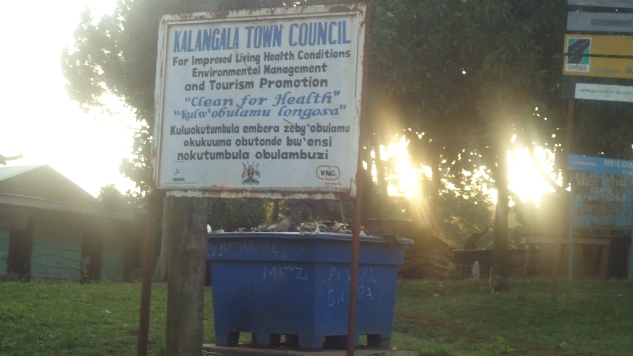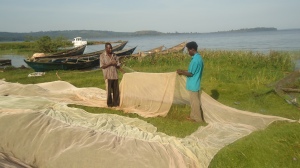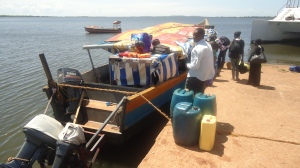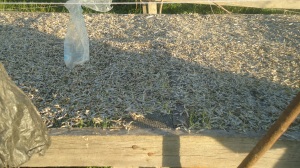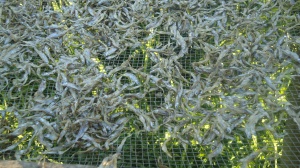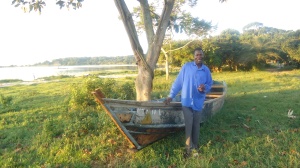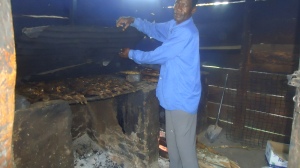I arrived at Nakiwogo in Entebbe, at around midday. The journey from the old taxi park to Entebbe had been long. It is only 36 Km. But since I did not know the time when the ferry was to depart, the journey seemed to have taken longer. There were conflicting times of departure: 11:00 am, midday, 1:00 pm, 2:00pm … I did not want to take chances since the ferry made just one trip a day.
I got off the taxi at the park in Entebbe Kitoro, and got onto a boda boda. This took me to Nakiwogo, where the ferry docks.
There were two ferries docked at Nakiwogo, and a boat. My mind was on the ferries. But I later learnt that the ferry which pried that route had broken down, and we were to use the boat.
Was the boat safe? I wondered, but with no other means of travel, I had no choice but to use it.
The boat, a water taxi with seats and a roof, departed a few minutes after two, in the afternoon. The trip lasted three and a half hours. It was long. One of the engines got a problem along the way. We had to cover several miles with one. We also battled waves that made the boat rock. The faint hearted started thinking of death. It seemed as if we would not reach our destination. But we eventually reached Lutoboka landing site on Bugala Island, Kalangala district. Bugala Island is one of the Ssese Islands.
I saw fishermen repairing fish nets and boat, as soon as I got off the boat. Instinct dictated that I approach them. And I did. One of them was Okumu Donato, the secretary for the beach management unit (BMU), at the landing site. This unit is tasked with fighting illegal fishing, empowering the welfare of farmers, promoting hygiene on the Island, improve tax collection and promote sustainable fishing.
Okumu gave me a tour of the landing site, especially the fishing activities. The nets I had seen after stepping foot on the Island, were nets for fishing silver fish. Since the moon was out, the fishermen were repairing them to put them in storage for one week until the moon was gone. Silver fish is fished using nets and steamer lamps, when there is no moon light.
There were drying units for silver fish at the shore. These are managed by Basookakwavula women’s group, which is funded by the Rotary club of Kampala. This is one of the ways to boost the women’s incomes since women do not fish.
I saw fish storage boxes. These are steel cases where fish is preserved before transportation. They are filled with ice. Fish can be kept there from two to three days, up to a week.
Donato informed me that the storage boxes are used because of the need to supply fish for export and to other markets. This was not necessary long time ago, where fishing was done to provide fish for a household. Fishermen would eat most of the fish. What they were not able to consume, they would salt it or smoke it, to preserve it. They was no need for the storage boxes.
He took me to his home where he was smoking fish. The system is of a firewood stove with a brick-walled platform, with wire mesh on top. The fish are put on the mesh and covered with iron sheets to retain the heat. The heat below is powered by firewood. After the fish have been smoked, firewood is roomed and they are left to cool, before they are stored.
He had chicken, ducks and pigs at home. This, like with other fishermen, is to supplement income from fish. Some farmers do gardening, but in small gardens. When they is little fish or the seasons do not allow them to fish, farming enables the fishermen to survive.
I was quick to notice that most houses were timber walled and temporary. Donato informed me that it’s because the landing site is in a forest reserve and the fishermen had not got permission to set up permanent houses. Also, fishermen are on the move most of the time, so there is no need of building permanent houses. He helped me to find a place where I would sleep before we parted ways, agreeing to resume the next morning.
Fishermen wake early. By 7:00 O’clock, they are awake. I met two fishermen, Okello James and Lwanga Kabogoza. They fish together and have been fishing for over twenty years. They specialise in silverfish (Mukene). Okello is 33 years and has been fishing since he was 7 years. Lwanga is 30 years old. He has been fishing since he was 10 years.
They did not go to school. Fishing is all they know. They informed me that they fish when it is dark. When there is moonlight, there is too much light in the water which scares off fish. You cannot attract then to the net, to trap them. That is why they do not fish. The moon spends a week when it is out (full moon). During that week, they do not fish. They repair their nets and collect firewood which they sell to people especially those involved in fish smoking. They also do gardening, and rest. This period is called “Njako”.
If they are to fish, they leave the Island at around 5:00pm in the evening and return at 6:00am or 7:00am. They dry the fish immediately. Silver fish for human consumption is dried on the drying units to avoid contamination with sand. The one to be used for chicken feeds is dried on the sand to get the additional nutrients from the insects and sea shells in the sand, that chicken need.
The net they use for fishing has between nine to fourteen sections called “golofa”, bound together with strings. They use six steamer lamps to trap the fish. Long ago only one steamer lamp and a smaller fish net, were used. This kind of fishing is called “Hurry up” and it is done in the middle of the lake. They usually fish from ten or twenty basins of silver fish on a good day. On a bad day, they fish 6 basins.
They told me that on Buvuma Island, silverfish is fished near the shore, mostly by women. The fish net has six sections. The type of silverfish trapped this way is “silver fish of the shore”, locally named “Mukene owokutaka.”
When I inquired about the fish volumes at the Landing site, I was informed that there is less fish because of the wind. If the lake is calm, there is more fish. If the lake is unstable, it drags dirt from the shore into the lake, which chases the fish away.
Donato tool me to a fish cage in a few meters into the lake. It was during his trip in the afternoon to feed the fish. Fish are fed three times a day, at 7:00 am, 1:00pm and 5:00pm. The cage project was pioneered by the deputy RDC of Kalangala, and it is managed by Lutoboka Cage Farmers Association. It is a pilot project, meant to test the sustainability of cage fish farming.
There are 20 cages, made out of mesh, wood and empty metallic drums. It is kept in place with anchors. Only one of these cages has fish. There are 1200 fish in it much as a cage is supposed to have a minimum of 3500 fish. I was informed when the project is tested, more fish will be introduced.
There are other types of fish caught at the island. Tilapia, sprat and Nile perch are among them.
Sprat (Nkejje) is fished near the shore and the beaches, in the evening and during morning hours. It is trapped with a net. This net is thicker than that used to fish Mukene. Tilapia is mostly fished with nets. Nile perch is fished using hooks. Nets are discouraged to support sustainable fishing and to discourage the fishing of immature fish.
I paid a visit to a fisherman’s home. He had a chest with 1000 hooks. These were of size 12. The small the hook size, the bigger the hook. U was struck by the small size of the hook. When I inquired why the hook used to fish such a small fish is small, I was told that once a hook gets into the gums of the Nile perch, it can’t break free. A sprat is usually put on one end of the fish. The hooks are put in water five meters apart. Not all of them get fish, though. Sometimes, the fishermen get between 10 to 20 fish of different sizes.
I took time to tour the Island. I visited the Kalangala District headquarters, the radio station and the several beaches. Not only is the Island a centre of fishing but also of tourism and political activity. The beauty there cannot be described. It can only be witnessed.
I left the Island the next day at 7:40 am. The boat usually leaves at 8:00 am. But it was full by 7:30am.. That’s why we left early. Once the boat departs before you board, you have to wait for it the next day or travel to another landing site and use the ferry to Bukakata. From there, you board a taxi from Masaka, to Kampala.
On my way back, I eavesdropped in a conversation of what fishing was like long ago. No one caught silverfish those days. It was left in the lake for the birds. The lake used to glitter because of them. It birthed a saying that “you glitter like silver fish.” Those days, the fish volumes in the water were high, unlike now.
I was left to imagine what that felt like, seeing fish floating on water. But I guess we will witness it one day.
Mulumba Ivan Matthias
